Starts decline in Q3, but not in September
Housing starts decreased modestly in the third quarter from the pace registered in the first half of the year. But oddly enough, housing
starts were actually up in September relative to the August level, despite the fact that the September 11 attacks probably influenced
housing construction during the month. In reality, it is difficult to see the impact of the terrorist attacks on housing activity. In
September alone, starts decreased in the Northeast and Midwest regions of the country, but increased in the South and West.
Looking at the housing data by type, single family and multi family construction both increased in September.
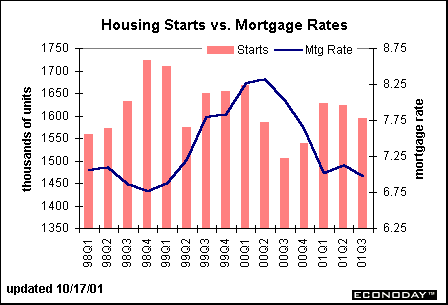
Taking a longer-term perspective, the pattern of construction for single-family units follows very closely with that of total starts. The
data shows that housing activity picked up steam again in 2001 as mortgage rates dropped off sharply. Single-family homes are very
sensitive to interest rate movements. That is not always the case with multi-family construction. The chart below shows how
construction of multi-family units have decreased over the course of 2001 despite the fact that mortgage rates had declined during
this period. Multi-family construction is down 2 percent in the three quarters of 2001 relative to 2000 as a whole. Multi-family housing
starts are more likely to be built on speculation than single-family housing. This slight decline in 2001 relative to last year could
indicate a reduced inclination to build speculatively.
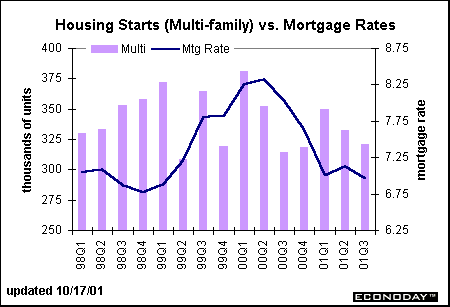
As we noted in the title of this article, housing construction really is local or regional in flavor. The regional nature of housing starts
reflects not only the economic environment of the region, but also longer term demographic needs. Actually, demographic
movements in themselves reflect the economic strength of the region as well, since people are more likely to move to a bustling area
than a depressed one.
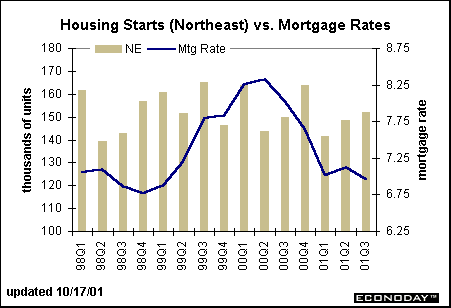
The Northeast region of the United States is a mature one where housing construction is mostly related to replacement of older units.
It may also show some upgrading of housing from smaller to larger units. (In the 1990s, "starter" mansions were the rage and large
scale homes were built on small lots.) Northeast housing activity always shows the smallest number of units in the region.
Activity in 2001 is weaker than 2000, but on the whole starts were relatively stable in this region in the 1998 - 2001 period we are
depicting here.
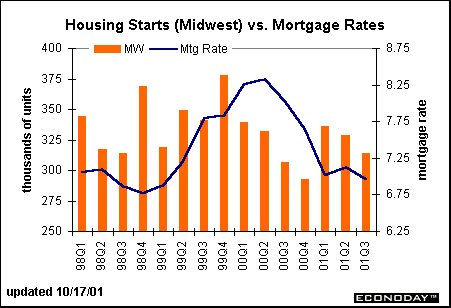
Housing activity runs at about twice the pace in the Midwest as seen in the Northeast. The Midwest also is a mature area, but room
for new construction is readily available. Despite the fact that housing starts are coming down in 2001, the level of overall activity is
still slightly stronger than it was in 2000. Lower mortgage rates coupled with improved income continued to spur activity despite the
fact that the Midwest has a heavy industrial sector that was clearly in recession over the past year. Perhaps not surprisingly, the
downward trend in housing activity is most apparent in this region where manufacturing activity is more important to the local
economy than in other regions of the United States.
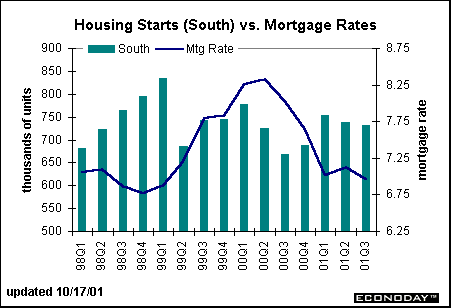
Housing activity in the South has fallen off very little in the past couple of quarters and reflects stronger activity in 2001 relative to
2000. The South also has a strong industrial base, but the recession in the manufacturing sector didn't seem to hurt housing activity
all that much in this region.
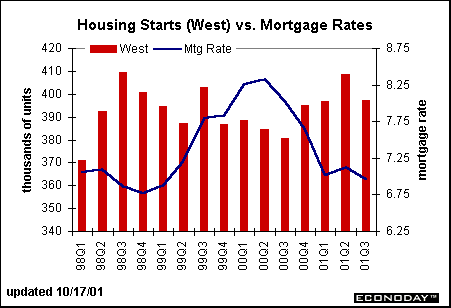
Housing activity declined in the third quarter from the strong pace shown in the second quarter, but was well in line with levels seen in
the first quarter of the year. Indeed, not only is housing construction stronger in 2001 than in 2000, but it rivals with the pace seen in
1999.
The bottom line
A strong housing market leads to healthy demand for furniture and appliances and home furnishings. This would mean that building
supply dealers such as Lowe's and Home Depot would benefit from healthy housing activity. Strong housing also means increased
demand for furniture so that companies like Ethan Allen and LazyBoy would benefit. For those investors who are following the Peter
Lynch principle of investing and buying stocks of companies with which you are familiar would be encouraged to buy some of the
stocks we mentioned if you saw that your local area housing market was booming. It is well to remember that stocks are national
rather than regional and therefore it is important to consider the national pace of housing activity, not just the local one. If you were to
look at a chart of these companies over the past three years, you would find some gains as well as some losses, but they certainly
would show a relationship to housing activity.
Evelina M. Tainer, Chief Economist, Econoday
| 